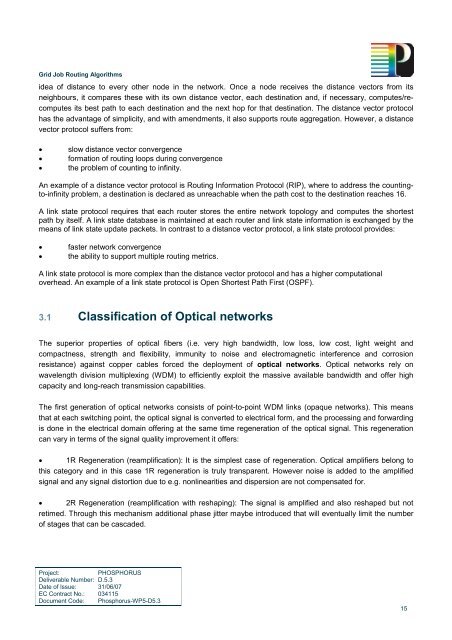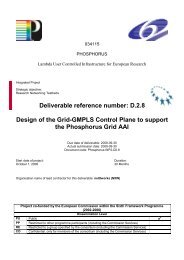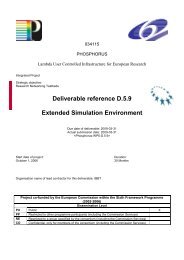Grid Job Routing Algorithms - Phosphorus
Grid Job Routing Algorithms - Phosphorus
Grid Job Routing Algorithms - Phosphorus
You also want an ePaper? Increase the reach of your titles
YUMPU automatically turns print PDFs into web optimized ePapers that Google loves.
<strong>Grid</strong> <strong>Job</strong> <strong>Routing</strong> <strong>Algorithms</strong>idea of distance to every other node in the network. Once a node receives the distance vectors from itsneighbours, it compares these with its own distance vector, each destination and, if necessary, computes/recomputesits best path to each destination and the next hop for that destination. The distance vector protocolhas the advantage of simplicity, and with amendments, it also supports route aggregation. However, a distancevector protocol suffers from:• slow distance vector convergence• formation of routing loops during convergence• the problem of counting to infinity.An example of a distance vector protocol is <strong>Routing</strong> Information Protocol (RIP), where to address the countingto-infinityproblem, a destination is declared as unreachable when the path cost to the destination reaches 16.A link state protocol requires that each router stores the entire network topology and computes the shortestpath by itself. A link state database is maintained at each router and link state information is exchanged by themeans of link state update packets. In contrast to a distance vector protocol, a link state protocol provides:• faster network convergence• the ability to support multiple routing metrics.A link state protocol is more complex than the distance vector protocol and has a higher computationaloverhead. An example of a link state protocol is Open Shortest Path First (OSPF).3.1 Classification of Optical networksThe superior properties of optical fibers (i.e. very high bandwidth, low loss, low cost, light weight andcompactness, strength and flexibility, immunity to noise and electromagnetic interference and corrosionresistance) against copper cables forced the deployment of optical networks. Optical networks rely onwavelength division multiplexing (WDM) to efficiently exploit the massive available bandwidth and offer highcapacity and long-reach transmission capabilities.The first generation of optical networks consists of point-to-point WDM links (opaque networks). This meansthat at each switching point, the optical signal is converted to electrical form, and the processing and forwardingis done in the electrical domain offering at the same time regeneration of the optical signal. This regenerationcan vary in terms of the signal quality improvement it offers:• 1R Regeneration (reamplification): It is the simplest case of regeneration. Optical amplifiers belong tothis category and in this case 1R regeneration is truly transparent. However noise is added to the amplifiedsignal and any signal distortion due to e.g. nonlinearities and dispersion are not compensated for.• 2R Regeneration (reamplification with reshaping): The signal is amplified and also reshaped but notretimed. Through this mechanism additional phase jitter maybe introduced that will eventually limit the numberof stages that can be cascaded.Project:PHOSPHORUSDeliverable Number: D.5.3Date of Issue: 31/06/07EC Contract No.: 034115Document Code: <strong>Phosphorus</strong>-WP5-D5.315






